In my first article on the Pancha Prana – Understanding Yogic Anatomy– we looked at two of the 5 Vayus – 1. Prana Vayu and 2. Samana Vayu. Let us now continue our journey of understanding the yogic anatomy by exploring the remaining 3 Vayus.
3. Apana Vayu- governs our excretory and reproductive systems
Apana is the Vayu of exhalation and elimination; and is the energy responsible for anything that moves down and out. As a comparison, once cooking is over, we need to clear out and dispose off the waste generated during the process of cooking. This is what Apana does.
In Prana Vayu we were focusing on inhalation and in Apana Vayu, we focus on exhalation. Prana and Apana are opposite forces but they complement each other and work together to keep our system clean and healthy.
Balance is the key not only in yoga practice, but in life as well!
Apana Vayu at the Physical Level – the cleansing breath
Apana is located in the lower abdomen; it moves down and out. Its movement is in line with the earth’s gravitational pull. So we can think of Apana (exhalation) as the settling energy, which helps us feel grounded, stable and calm.
It is our anchoring breath and is responsible for removing unwanted things, in the form of toxins, sweat, stool, urine, gases and carbon dioxide during exhalation. Hence it is also known as the cleansing breath.
Imagine what will happen if we are unable to release these wastes from our system. If we are constipated for longer periods, we will feel sick, bloated, nauseous and will not feel like taking in food. Our body knows that if it cannot get rid of the physical waste, it will not have the ability to digest things what we are taking in.
So when you do not feel hungry, do not have food. Your system knows better than you do. Never look at the clock, and say “hmmm.. Its 1 pm; time to have lunch”. Do not do that.
If you have gas issues, try to avoid raw sprouts, raw vegetable and lactose. Each one’s body constitution is different. So try to find out the root cause of it. You can try having a piece of organic jaggery after meals.
Apana Vayu at the Mind level – Getting rid of unwanted thoughts and emotions
At the mental level, when we find it difficult to let go of unwanted, wasteful thoughts and negative emotions; and keep holding on to them, it will lead to the constipation of the mind. Do not suppress your emotions, as it will restrict the natural flow of Apana and will build up emotions, leading to an unhealthy mental state.
Journaling is a powerful practice for both mental and emotional health; write whatever is on your mind. There is no right or wrong. Continue writing until you feel ready to stop. If you do not like to write, speak to someone.
If no one is around, talk to plants and release the pent up feelings. Plants bring joy and control to our thoughts during chaos and reduces symptoms of depression.
In medical terms, Apana controls our defecation and urinary reflexes. When the bladder is full, stretch receptors present in the bladder, signal the sacral cord (lower portion of spinal cord); which in turn sends back signals to the bladder to initiate urination.
In women, Apana is responsible for menses and is the moving energy behind the process of childbirth. In men, it is responsible for ejaculation. When Apana Vayu is weak, you may become susceptible to illness, because you are unable to release toxins from your body. At the mental level, you will have anxiety, fear, doubts and a feeling of exhaustion due to overthinking.
A weak Apana causes constipation at both physical and mental level.
In Yoga, the most difficult asana is to “LET GO”
Apana is all about release i.e. physical and mental release.
Some important tips for improving your Apana are –
- Remember, what goes in should go out as well; like food, breath, thoughts, etc. When you are clearing out things which you no longer need – like files, clothes, shoes or even relationships, your Apana is at work.
- If you feel, you are unable to let go of things at the mental level, then practice kapalabhati kriya, which focuses on exhalation; as exhalation relates to Apana.
- Next time you have a troubling thought, emotion or sensation, use your breath to relax. Do deep breathing, inhale peace and exhale anxiety (try to make your exhalation longer than your inhalation).
- Do Chandra Namaskar in the evening, which also has calming effect.
- If you have constipation, diarrhoea, urinary tract infection, reproductive issues, that means your Apana Vayu is in imbalance. As Apana is responsible for our stability, all the poses in which we try to find balance – like the tree pose, lunges, warrior pose, dancer pose (natrajana) will be helpful.
- Asanas and exercises that focus and engage the lower abdomen, like wind expeller, boat, child pose, forward bending, twists, etc. will help in balancing Apana Vayu.
- The Apana Vayu mudra will also help in balancing Apana.

4. Vyana Vayu- Governs our Circulatory system
Vyana vayu is responsible for distribution of energy and provides nutrients and oxygen to various systems of the body via blood flow. In a restaurant, once the food is ready, the waiter serves it at appropriate tables and collects waste from the table.
This is what Vyana does. It makes sure that oxygen, nutrients and energy are distributed well into the system for its healthy functioning. At the same time, it carries cellular waste away.
It moves from the centre towards the periphery and hence it is also known as expansive energy. It is present all over the body, but mainly a bit focused towards the extremities i.e. arms and legs; because its movement is towards the periphery. There is no specific working area of Vyana; it works in coordination with other Vayus. It not only connects everything in our body but also helps us connect with the world.
Example: You feel a sense of happiness when you express and share your experiences with family or friends. Likewise, you get a feeling of joy when you are walking in the midst of nature. These are the expression of Vyana vayu.
Vyana Vayu at the physical level – responsible for movements in the body
All the movements are due to the contraction and relaxation of muscles, which is done by Vyana; with the help of proper coordination with and cooporation of other Vayus.
At the physical level, Vyana is the energy that regulates our system and makes sure that our systems are functioning properly, by supporting the functioning of other vayus.
If Vyana is free flowing, it will ensure proper blood flow through the circulatory system, unobstructed flow of fluids through lymphatic system and a smooth passing on of signals to the neurons in the nervous system.
It is also responsible for our muscular coordination while walking, running or doing any activity. If one of the body parts or organs is receiving less amount of Vyana, then there will be insufficient circulation of oxygen and nutrients. This will lower the efficiency of that particular part or organ, leading to health issues or muscle cramping.
Vyana governs the movement of Prana through 72,000 subtle energy channels called Nadis. Any blockage will lead to one or the other problem; physically as well as mentally. Vyana acts as an energy reserve and is responsible for managing our energy throughout the day. Whenever there is a shortage of energy in any part of the body; it sends the required nutrients to the cells, to produce energy.
It makes sure that our energy levels are high during the day, for doing all the required activities; and during evenings, as we wind up, the energy decreases, so that we can have a peaceful sleep.
Our body has different systems but each system cannot function in isolation. They all work together and influence each other due to their interconnection.
Vyana Vayu at the mind level – free flow of thoughts and emotions
At the mind level, when Vyana is free flowing, it allows a free flow of thoughts and emotions. When it is stagnant, everything feels more challenging.
Mentally, you might find it difficult to coordinate and balance your personal life, career path and spiritual growth. Physical imbalance may show up in the form of poor circulation, joint or muscle aches, arthritis, nervous system disorder, low energy or compromised immune response related to lymphatic system.
So , here are some ways to strengthen Vyana –
- As Vyana is the vayu of integration, five sets of sun salutation in the morning, with proper coordination of the whole body’s movements and breath, will help in enhancing and strengthening Vyana.
- All standing poses, involving the whole body’s movements, like the variations of the warrior poses, will also help.
- Go for a walk. While walking, keep focusing on your breath, to de clutter your mind.
- Nadi shodhan/ alternate nostril breathing will help in clearing up the nadis/ energy channels and thus, enhance the flow of Prana.
- While inhaling, visualise that the energy is spreading all over the body and each part is being energised. Vyana Vayu mudra will also be helpful.
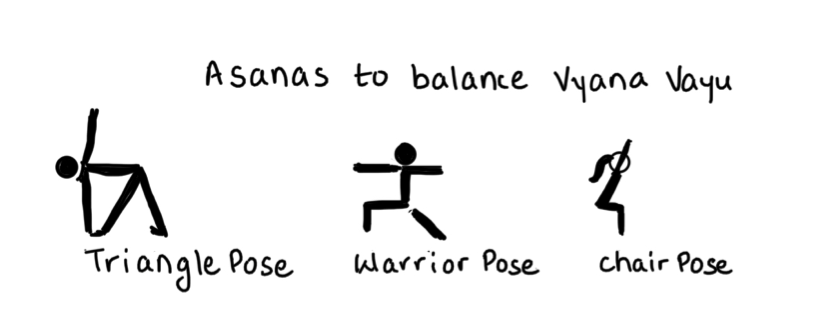
5. Udana Vayu- governs our nervous system
In Sanskrit, Udana literally means “air that flies upwards”. This energy moves in the upward direction from the neck to the head. It is responsible for higher thinking capabilities, creativity, reasoning and logical thinking; and takes care of our neurological system.
It is just like the head chef of a restaurant who makes a strategy, does the planning for the entire restaurant and assesses the quality of food.
Udana at the physical level – responsible for communication
At the physical level, it is responsible for our speech. We exhale while speaking; and, the longer our inhalation, the more words we can produce clearly, as we breathe out.
Udana not only empowers our speech, but also inspires the thoughts behind our words. Udana thus, impacts our communication and learning; and governs our growth.
Udana gives strength to the neck muscles to support the weight of our head. It is because of Udana, we are able to stand upright. The neck is the bridge that connects our head (central nervous system) with the rest of the body.
To sustain a healthy life, Prana (chest), Samana (abdomen) and Apana (lower abdomen) must be in balance, as these three Vayus act as the foundation for Udana, which helps us grow.
This ensures, we are able to take in Prana, digest our food well and remove our waste properly from our system. Proper functioning of the systems will provide ample energy and strength for us to work upon our personal growth.
On the other hand if the foundation is weak, that is, we are not getting enough life force, unable to digest and clear the waste out of the system, including our thoughts, then, self-expression, growth, creativity, communication will not happen.
If there is lack of communication, then there will be difficulties in relationships. You will be unable to face challenges or situations so will try to avoid them. Many a times we do not feel like coming out of our comfort zone. It becomes a challenge for us.
Remember, it is the space of discomfort, where growth takes place. We will have a feeling of being stuck mentally as we are unable to change or evolve. We need to nurture Udana to develop our body and evolve our consciousness.
You may be knowing people who talk a lot and keep repeating everything. They only focus on talking and so they are less receptive to ideas or information. This eventually hampers their learning and growth process. Excessive Udana is responsible for this, so we need to work on it.
In short, Udana is responsible for our expression, swallowing, communication, speech, articulation. It governs our growth and metabolism, through thyroid and parathyroid glands. Nervous disorders can lead to lack of cognitive skills.
Udana at the Mind Level – Clarity of thoughts
At the mental level, we are not receptive to new ideas or information because we have a feeling of always being right, which leads us to being a bit arrogant or inflexible. It becomes hard to swallow information.
In other words we become stiff necked. Some key aspects about strengthening Udana are –
- If Udana is balanced, we have clarity of thoughts and good control over whatever is happening around us.
- Udana is very important for spiritual growth. As it relates to spirituality, chanting mantras and meditation will strengthen it by elevating our thoughts and calming our mind. When yogis master Udana, they reach a higher state of consciousness.
- Pranayama exercises such as Ujjayi (humming bee breath), will certainly help strengthening the Udana and stimulate our thyroid glands.
- Applying Udana Vayu mudra and doing ten rounds of deep breathing will also help.
- Chin lock will also enhance Udana. People having BP, cervical, vertigo issues should avoid and if you feel uncomfortable do not apply chin lock.
- Shoulder stand, plough pose, bridge pose will also be very helpful. People having high BP issues, heart and neck issues should avoid shoulder stand and plough pose.
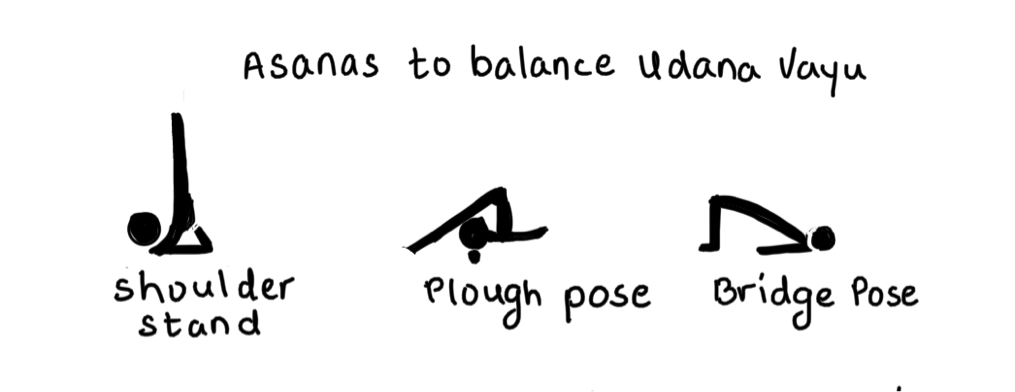
Conscious acknowledgment of all five Prana Vayus will make us aware of our own body; which will help us incorporate specific asanas in our daily practice according to the need.
Once you get a clear vision of location and direction of movement of these specific Vayus, it becomes much easier to work on it.
Check out the Youtube Channel of Neelu Kalra for more Yoga related Insights.
Please do share your comments in the section below; like and share the article further if you find it useful.
Please do leave your comments at the bottom and do share with others if you like this article.


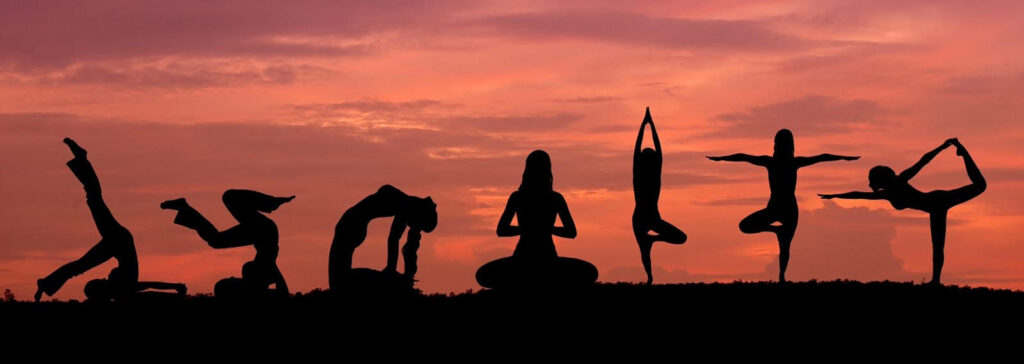









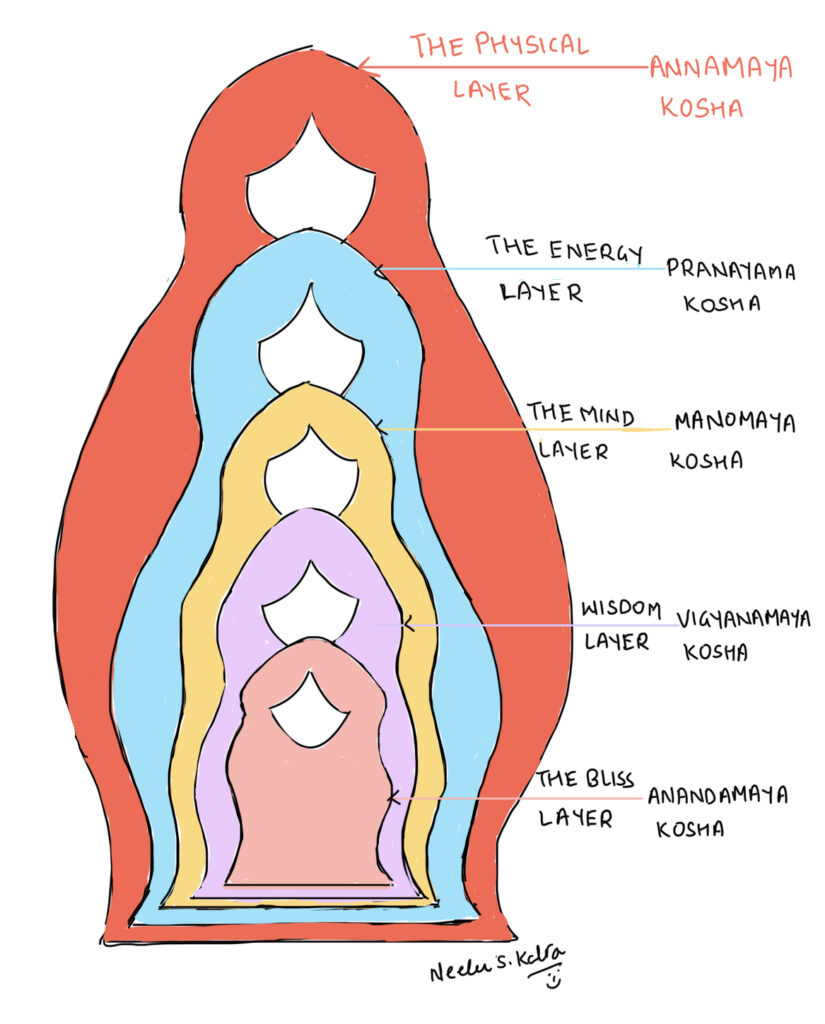
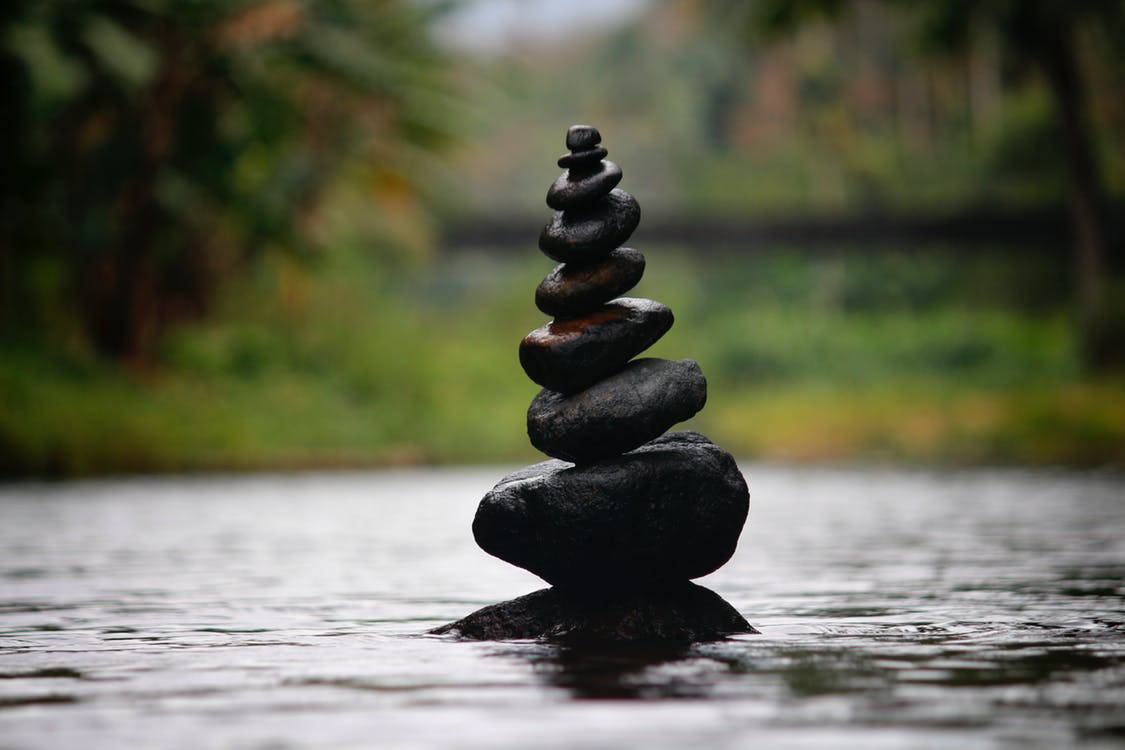



Great… well explained